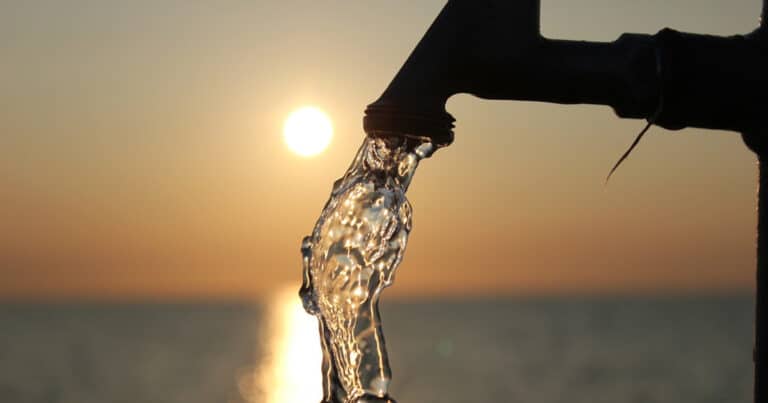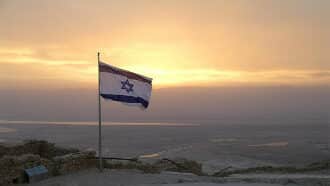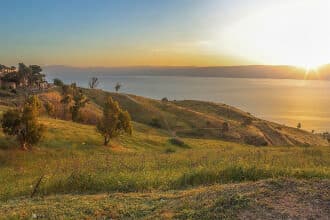By Harry Cooper – While the earth is covered in water, 99% of it is unusable. Only 2.5% of the earth’s water supply is fresh water, and of that fresh water supply around 70% of it is frozen in glaciers and ice caps, leaving relatively little water available for human consumption.
A World Wide Water Crisis
As human populations multiply, this small amount of water gets stretched dangerously thin, leaving many parts of the world with limited access to clean water. The growing issue of water scarcity has prompted many people to look for solutions into the ways we use water, and where we get our water from.
What is Desalination?
One such solution is the process of seawater desalination. What is desalination? Desalination is the process of taking large amounts of undrinkable seawater or brackish water, removing the salt and other contaminants, and turning it into potable water.
While desalination has proved itself a viable way to remove drinking water contaminants and alleviate water scarcity, it is not without its flaws. Desalination plants are often very expensive to run and require massive amounts of energy. This has made it harder to utilize seawater desalination on a large, global scale.
The Desalination Process
Seawater is far from being drinkable when taken straight from the ocean, and it must undergo intensive desalination processes in order to become usable. The two main methods of seawater desalination are multi stage flash distillation and reverse osmosis.
Multi Stage Flash Distillation
One of the easiest ways of separating water from its contaminants is by using heat. Heated water gives off steam which can be condensed as desalinated water. On an industrial level, this is done through a process known as multistage flash distillation.
This process involves using a series of increasingly lower pressure chambers to rapidly boil water and create steam at desalination plants. Once enough clean water has been removed as steam, the excess concentrated brine is discarded.
Reverse Osmosis desalination plant
Unlike multi stage flash distillation, a reverse osmosis desalination plant relies on pushing seawater through semipermeable membranes at incredibly high pressures. These membranes filter out larger contaminants and salt particles to turn salt water into drinkable freshwater.
The process of reverse osmosis is very efficient at desalinating water. However it is incredibly expensive compared to thermal desalination processes.
This makes it much harder for reverse osmosis desalination plants to be installed in poorer, more water stressed areas. Although as desalination technologies improve and become less expensive, we can hope to see a more widespread use of desalination through the construction of desalination plants.
Restoring Water Balance
Dwindling water supplies has made access to water a source of conflict in many water stressed parts of the world. But many believe that increasing water supplies through desalinated seawater can help to spark negotiations and spread peace.
Israel: A Case Study on Desalination
Over the past decade, Israel has invested lots of time, money, and resources into building its desalination infrastructure; including the largest desalination plant in the world: the Sorek Desalination Plant.
This freshwater producing infrastructure is especially important in a region like the Middle East, one of the driest and most water stressed parts of the world. But, with so much conflict between the countries and peoples of the region, many question whether Israel’s water supply will be another source of controversy, or the key to peace and prosperity in the Middle East.
Restoring Israeli Water Supply
The historic diversions of water from the Jordan River, and its tributaries in Syria and Jordan, has put many of Israel’s iconic natural water bodies under extreme duress, but Israel’s development and new reliance on desalination has helped restore it into a water rich country. While the Sea of Galilee has shrunken considerably due to water usage and climate change, Israel has now set in place plans to move excess desalinated water back into the Sea of Galilee, to restore it to its former glory. In addition, some have discussed using the excess salt water from the desalination process to replenish the shrinking Dead Sea. Along with renewing these water bodies, Israel is also using its newfound water source as a means of diplomacy.
Using Water in Peace Negotiations
With almost the entire region of the Middle East being plagued by water scarcity, drinkable water is a valuable commodity. And with Israel’s new influx of desalinated water, they are beginning to use it as a bargaining chips in peaceful negotiations with its neighbors.
One such water trading treatyhas been made with Jordan, and brokered by the UAE. The treaty promises that Israel will provide Jordan with 200 million cubic meters of fresh water in exchange for 600 megawatts of solar generated electricity. Renewable energy for potable water!
Desalination and Palestinian Peace
Another key issue in the reworking of the Middle Eastern water balance through desalination, is the Israeli-Palestinian conflict. Water has been an issue between Israelis and Palestinians for as long as the conflict itself, both sides vying for access to the limited fresh water.
But as Israel increases its water supply through desalination, there is room for both Israelis and Palestinians to have enough clean water. While there is still a lot of work to be down to solve the conflict, thanks to desalination plants, we can hope to see everyone in the region with access to fresh water.
Desalination and Religion
Exodus 15:22 – Then Moses Caused Israel to Set Out from the Sea of Reeds. They Went on Into the Wilderness of Shur; They Traveled Three Days in the Wilderness and Found No Water.
“Appreciating Water” By Rabbi Yonatan Neril and Evonne Marzouk, Eco Bible Volume 1
Even before the Israelites entered the Land of Israel, water was central to their collective experience. In the desert, uncertainty about water resources inspired numerous complaints and lessons for the wandering Jews.
The Talmud teaches that in the spiritual merit of Miriam’s song, a well appeared in the desert and accompanied the Israelites wherever they went. God gave this essential resource, without which one cannot live for more than a few days, in the water-scarce desert. But the long-term security of the resource was never certain. The Biblical experiences with water in the desert can be understood as a spiritual training to cultivate appreciation for God’s goodness. Through the process of taking water for granted, losing it, and then receiving it directly from God, the desert wanderers certainly appreciated water and the One who provided it. Thus, at the end of the Israelites’ desert experience, they sang an exultant song about their appreciation of water to God.
Water scarcity continued after the Israelites entered Israel with Joshua and formed an agrarian society whose bounty or famine was regulated by rain. The Talmud teaches that God directly waters the Land of Israel while a messenger waters the rest of the world. Israel is a semi-arid country with no major rivers. It receives modest rainfall, averaging less than four inches (100 millimeters) per year in the extreme south to 44 inches (1,128 millimeters) a year in the north.(By comparison, New York City averages between 28 inches [710 millimeters] and 45 inches [1140 millimeters] of precipitation per year.) Why is the one land in the world that God waters directly a land that receives far less water than many others? Since water is a sign of blessing, would not the Pacific Northwest or the rainforests of Brazil or Indonesia be more appropriate candidates for the Promised Land?
Water insecurity is by Divine design, to remind us that God is the ultimate Provider of all our needs. The Land of Israel contrasts with the land on both sides of the Nile, Euphrates, and Tigris rivers. In those river valleys, farmers can irrigate their crops year-round from a reliable water source. Yet until the twentieth century, most agriculture in Israel was rain-fed and not irrigated. The seven species that the Torah associates with the Land of Israel (grapes, olives, dates, pomegranates, figs, wheat, and barley) are all species that do not require irrigation. The farmers who planted, tended, and harvested these crops depended on the winter rains to survive. In their acute need for rain each year, the Israelites depended on the God who provided it, a spiritual reality that was not present in the more water-abundant river valleys of nearby civilizations.
Today, Israel is working hard to address a recent water crisis spurred by a long-term drought induced by climate change. Reuse of wastewater for irrigation is a key method for increasing the supply of available water. Desalination of Mediterranean seawater is becoming an increasing source of freshwater, yet requires a significant amount of energy to produce the water – energy currently supplied by burning fossil fuels.
The world faces a growing water crisis particularly affecting the people of Africa, Southern Asia, and China. Indeed, insufficient safe drinking water is a leading cause of death in the world. Some 884 million people do not have access to safe drinking water sources. A 2018 UN-Water report notes that “over two billion people live in countries experiencing high water stress.” The Torah’s wisdom on water awareness is more relevant now than ever.
* Featured image source








